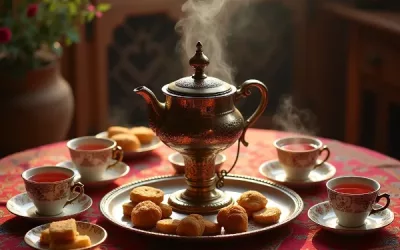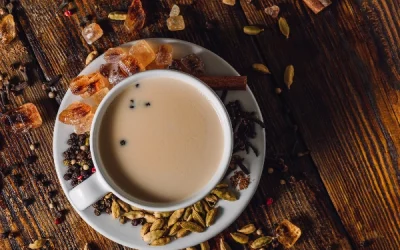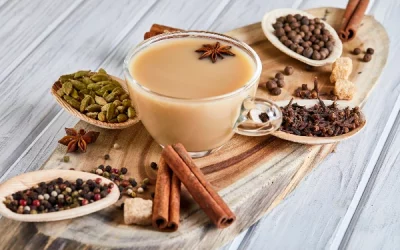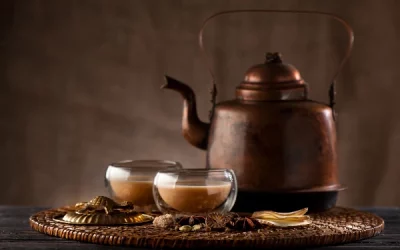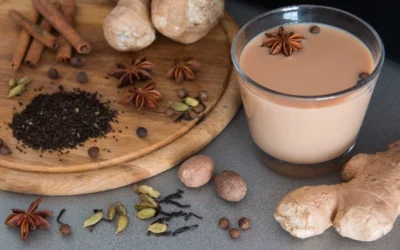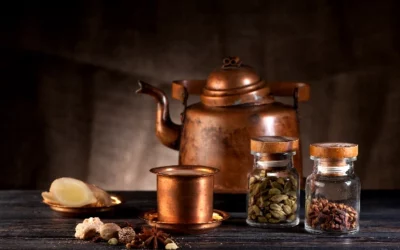From chai teas rich history infused with cultural significance to the step-by-step process of brewing the perfect cup, you’ll discover how to personalise your chai experience with custom ingredients and explore various tempting recipes. Join me as we delve into the fascinating story of chai tea, uncover its health benefits, and learn how to avoid common mistakes along the way. Let’s elevate your tea game together—your perfect cup of chai awaits!
Table of Content
- What is chai tea?
- What is chai teas history?
- What are the traditional ingredients of chai tea?
- How do you prepare traditional chai tea?
- What are the variations of chai tea?
- How can you customise chai tea recipes?
- What are the health benefits of chai tea?
- What are the common mistakes to avoid when making chai tea?
- How can you serve chai tea for different occasions?
- Conclusion
What is chai tea?
Chai tea, often simply called “chai,” is a spiced tea beverage deeply rooted in Indian culture. The word “chai” is derived from the Hindi term for tea, which itself originates from the Persian “chay” and ultimately from the Chinese “cha.” Thus, the term “chai tea” is somewhat redundant, as it essentially means “tea tea.” However, in Western contexts, “chai” has come to specifically refer to this unique spiced tea.
Traditionally made with black tea, a mixture of aromatic spices and herbs, milk, and sweetener, chai tea offers a rich and warming experience. This drink has evolved over centuries and continues to capture the hearts and tastes of people worldwide.
Chai tea has a rich history that ties back to ancient times when it was initially consumed for its medicinal properties. Over the years, it transformed from a simple herbal concoction to a popular everyday beverage, especially in India.
With British colonial influence, chai tea gained refined flavours, becoming an essential part of daily life in Indian society. Today, chai tea is enjoyed globally with many variations tailored to local tastes and preferences.
What is chai teas history?
The origins of chai tea date back thousands of years to ancient India and Siam (modern-day Thailand). Early versions of spiced tea were used in traditional Ayurvedic medicine, an ancient system of health and wellness practiced in India.
These early teas, which did not necessarily contain Camellia sinensis (tea leaves), were brewed with a variety of herbs and spices believed to have healing properties. The spices commonly used in these early brews included ginger, cardamom, cloves, and cinnamon, ingredients known for their medicinal benefits.
What is the origin of chai tea?
Chai tea’s origins can be traced back to ancient India. The earliest versions of chai were primarily herbal brews, used in Ayurveda, the traditional Indian healthcare system, for their medicinal properties.
These ancient brews often didn’t include tea leaves, sweetener, or milk, which are staples in modern chai.
- Initially a blend of herbs and spices used in Ayurveda
- Utilised for its believed health benefits like improving digestion and boosting energy
- Dates back several thousand years in Indian history
- Expanded influence across different regions in India, each adding unique ingredients
The cultural significance of chai tea grew as Indian society adopted it in daily rituals. Over time, the introduction of tea leaves through Chinese influence turned the herbal brew into what we now recognise as chai tea.
How did the British influence chai tea?
The British played a significant role in the evolution of chai tea, especially during the British colonial period in India. British traders introduced tea cultivation in India to break China’s monopoly over the tea market.
They established tea plantations in Assam and Darjeeling, leading to a significant cultural shift.
- British introduced commercial tea farming to India in the 19th century
- Promoted tea consumption, blending it with local spices and herbs
- Encouraged Indian workers on tea plantations to consume tea to boost tea demand
- Chai tea became a daily staple, blending Western tea-drinking habits with Indian flavours
The British influence led to the popularisation of black tea leaves in chai, which were combined with Indian spices, creating the beloved masala chai.
How has chai tea evolved over time?
Over the centuries, chai tea has evolved from a traditional medicinal beverage to a favourite drink enjoyed by people all over the world. This transformation reflects changes in taste preferences, cultural influences, and global trends.
- Modern chai tea often includes a variety of spices like cardamom, cinnamon, ginger, cloves, and black pepper
- Variations have emerged, such as spiced lattes found in Western cafes
- Served to reflect regional tastes, including vegan options with plant-based milk
- Gained popularity in countries like the U.S. and U.K. through cafes and tea brands
Chai tea’s versatility has allowed it to adapt and thrive, transcending its origins and becoming a global phenomenon.
In the early 20th century, the Indian Tea Association, influenced by British colonial interests, began to promote tea consumption amongst Indians. Street vendors, known as “chai wallahs,” started blending tea with a variety of spices, making the beverage affordable and accessible to the masses. This integral role of chai wallahs in popularising chai tea throughout India cannot be overstated.
What are the traditional ingredients of chai tea?
Chai tea is a fragrant and spiced drink that originates from India. Traditionally, this tea is made by brewing black tea with a mixture of aromatic spices and herbs. It is often served with milk and a sweetener such as sugar or honey.
Many find the combination of spices not only delicious but also comforting and warming. The traditional ingredients not only give chai tea its distinct flavour but also offer various health benefits.
To help you understand the traditional ingredients of chai tea, here’s a detailed table listing the ingredients, their roles in the chai, and their health benefits:
| Ingredient | Role in Chai | Health Benefits |
|---|---|---|
| Black Tea | Base of the chai | Rich in antioxidants, improves heart health |
| Ginger | Adds warmth and spice | Aids in digestion, anti-inflammatory properties |
| Cardamom | Provides aromatic sweet notes | Helps with digestion, has diuretic benefits |
| Cinnamon | Adds sweetness and warmth | Lowers blood sugar levels, anti-inflammatory |
| Cloves | Adds depth and spice | Antimicrobial properties, relieves pain |
| Black Pepper | Enhances heat and flavour | Aids in digestion, has anti-inflammatory properties |
| Star Anise | Adds a liquorice-like note | Helps with digestion and respiratory health |
| Milk | Provides creaminess | Source of calcium and vitamin D |
| Sweetener (e.g., sugar, honey) | Balances the spices | Provides energy, depending on type may offer various benefits like antioxidants (honey) |
Chai tea is more than just a beverage; it’s a wonderful blend of flavours with numerous health perks. Each ingredient complements the other, creating a perfect balance of taste and wellness.
How to make traditional chai tea?
Making traditional chai tea at home is a rewarding experience. It’s easy to customise the flavour to suit your preferences. Below are the steps and tips to create your own perfect cup.
- Gather ingredients: Collect all the ingredients listed in the table above.
- Boil water: Start with boiling water in a pot.
- Add tea leaves and spices: Add black tea leaves and the spices – ginger, cardamom, cinnamon, cloves, black pepper, and star anise.
- Simmer and steep: Let the mixture simmer for a few minutes to extract the flavours.
- Add milk: Pour in milk and bring the mixture to a boil again.
- Sweeten: Add honey or sugar to taste.
- Strain and serve: Use a strainer to remove the tea leaves and spices, then pour the delicious chai tea into cups.
Enjoy your chai tea hot, and share with friends for a comforting experience.
What variations exist for chai tea?
Chai tea can be as versatile as you want it to be. There are many variations you can try to create a unique cup that fits your taste.
- Masala chai: Includes additional spices like fennel seeds and mint leaves.
- Green chai: Uses green tea instead of black tea for a lighter version.
- Vanilla chai: Adds vanilla extract or pods for a sweet twist.
- Iced chai: Brew chai tea and cool it down, serve over ice for a refreshing treat.
- Vegan chai: Use plant-based milk like almond or soy milk instead of dairy milk.
Experimenting with different versions can lead to finding a new favourite chai tea.
Chai tea doesn’t just boast a rich flavour profile; it’s packed with history. For instance, the Assamese pioneers in India have a long history of producing black tea. They would often brew it with native spices for both flavour and medicinal purposes. The combination of tea with spices became so popular that it spread throughout India and beyond, laying the groundwork for the chai tea we enjoy today.

How do you prepare traditional chai tea?
So, you’re ready to dive into the world of chai tea, a delightful concoction that’s both cultural ritual and a flavour explosion. Let’s skip the fluff and get straight to answering how to whip up this traditional treat. Buckle up, tea-lover.
Firstly, let’s gather up your ingredients: black tea, a mix of spices (think cardamom, cinnamon, cloves, ginger, and black pepper), milk, sweetener (sugar, honey, or whatever floats your boat), and water. Ready? Let’s hit the chai-lights.
- Steep the black tea: Boil some water and throw in those black tea leaves. Let them get cosy and steep for a few minutes. No teabags here; we’re going grandiose!
- Add the spices: Next, bring out the big guns—your spice mix. Toss those into your simmering tea. The whiff of cardamom and cinnamon hitting that boiling water? Heavenly.
- Mix with milk: Now, it gets creamy. Simmer your spicy tea and gradually add milk. Achieve that perfect tea-milk equilibrium you dream of.
- Adjust sweetness: Ladle in your preferred sweetener. Taste it as you go; life’s too short for bland chai.
- Brewing techniques: Let the mix bubble and brew. Low and slow is the way to go for best results.
What are the steps to prepare traditional chai tea?
We already touched on the main steps, but let’s get granular here! After all, you don’t want to mess up a good thing.
- Step 1: Gather your ingredients.
- Step 2: Boil water, add in black tea leaves.
- Step 3: Toss in your spice mix.
- Step 4: Allow the spices to blend and steep.
- Step 5: Pour in milk slowly while maintaining a simmering heat.
- Step 6: Sweeten it to taste with your chosen sweetener.
- Step 7: Continue to simmer for a few more minutes to let the flavours meld.
Boom! You just brewed up some traditional chai tea.
How do you adjust the sweetness of chai tea?
Adjusting sweetness in your chai tea is as easy as pie—and more rewarding to the taste buds!
- Taste as you go: Always start with a little sweetener. Chai tea should be complex, not a sugar bomb.
- Use different sweeteners: Sugar is common, but honey, maple syrup, or even agave can add unique notes.
- Sweet spice trick: Consider adding a bit more cinnamon or star anise for natural sweetness.
- Portion control: You can always add more, but taking out excess sweetness is a Herculean task.
- Layering technique: Add sweetener in intervals, allowing it to blend thoroughly for consistent sweetness.
Remember, chai tea is all about balance. Sweeten it to complement the spices, not to overshadow them.
What are the different brewing techniques for chai tea?
For all you adventurous souls out there, let’s discuss different brewing techniques to elevate your chai tea game.
- Traditional stovetop: Simmer it low and slow on a stove. Patience is key.
- French press: For a quick brew, use the French press. Steep longer as the magic happens under that lid.
- Espresso machine steaming: If you’re fancy and own an espresso machine, use the steam wand for a creamy chai.
- Cold brew: Try cold brewing for a refreshing twist. Steep tea and spices in cold water for hours, then add milk.
- Pressure cooker: If you can’t wait, use a pressure cooker to blend flavours quickly.
Choosing the right method depends on your patience level and how deep you want those flavours to be. Be your own chai maestro!
Speaking of maestros, did you know that Mahatma Gandhi had a special relationship with chai? Though he abstained from it following his diet of simplicity, he recognised chai tea’s role in Indian society and even permitted it for his followers in ashrams during long days of civil resistance. Talk about a brew that’s fuelled change!
And there you go—every trick in the book to master the art of traditional chai tea. So go on, impress yourself and your taste buds. You’re now a bona fide chai expert!
What are the variations of chai tea?
Alright, let’s get cosy and chat about chai tea. This spiced elixir is beloved around the globe. If you think chai tea is just one thing, you’re in for a treat. There are multiple variations, each with its own unique blend of flavours and charm.
Let’s dive into the aromatic world of chai tea and explore the different variations, including Masala Chai, Assam Chai, Darjeeling Chai, and more.
What is Masala Chai?
Masala Chai is the rockstar of the chai tea world. Think of it as the bold, spicy sibling who always knows how to have a good time.
- It’s a blend of black tea, milk, and a myriad of spices.
- The usual suspects include cardamom, ginger, cinnamon, cloves, and black pepper.
- Sweetness levels can vary wildly, depending on preference. Some like it saccharine, some keep it mellow.
- Masala Chai is highly customisable. You can tweak the spices to your liking.
- This teatime staple is traditionally boiled and simmered, giving it a rich, full-bodied flavour.
Masala Chai is the go-to for those cold mornings when you need a warm hug in a mug. It’s like Harry Potter’s Butterbeer but for adults.
How does Assam Chai differ from other variations?
If Masala Chai is the life of the party, Assam Chai is the dependable friend who’s always there for you.
- Originates from Assam, a region in northeastern India known for its robust black teas.
- Has a malty and strong flavour, making it a great base for spice blends.
- Typically less spicy compared to its Masala cousin, focusing more on the tea’s natural flavour.
- Often enjoyed with a bit of milk and sugar, letting the tea leaves steal the spotlight.
- This variant is perfect if you want a morning pick-me-up with a strong caffeine kick.
Assam Chai doesn’t need fancy spices to prove its worth. It stands out with its own rich and bold personality.
What are the unique characteristics of Darjeeling Chai?
Darjeeling Chai is like that sophisticated cousin who’s been to more countries than you can name.
- Sourced from the Darjeeling region in West Bengal, India.
- Known as the “Champagne of Teas” due to its delicate flavours and distinctive aroma.
- Combines the lightness and floral notes of Darjeeling tea with subtle spices.
- Typically has a gentle, fruity, and floral flavour profile that stands out even when spiced.
- Less likely to be heavily sweetened or milked down, preserving the tea’s natural elegance.
Darjeeling Chai is perfect for those moments when you want to elevate your tea-drinking experience without drowning it in spices and sweeteners.
Meanwhile, in the interconnected world of chai tea, there are regional characteristics and experimental blends to explore. From fragrant spices varying by region to modern tweaks like vanilla or chocolate-infused chai, the spectrum is broad.
Long before Starbucks popularised chai lattes, ancient traders brought spiced tea from India to the West. One fascinating story is that of the British Raj, which played a significant role in making tea – and subsequently chai – a global phenomenon.
In the mid-1800s, the British began extensive tea planting in India. By the time the 1900s rolled around, chai tea had embedded itself into Indian culture, turning every street corner into a mini chail stall.
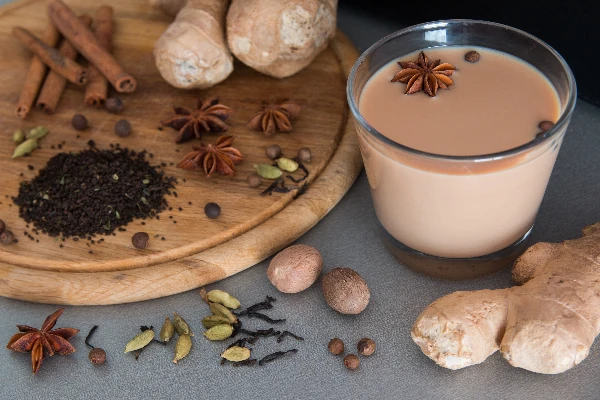
How can you customise chai tea recipes?
Chai tea isn’t just a drink; it’s a world of flavours waiting to be explored. You might have tried it at your favourite coffee shop, but did you know you can make it at home and totally tweak it to suit your taste buds? That’s right. Let’s dive into the different ways you can customise your chai tea recipe.
First up, the milk. Are you a fan of dairy? Maybe you’re lactose intolerant, or perhaps plant-based options are more your style. No worries, chai tea doesn’t discriminate. From cow’s milk to almond milk, there’s a plethora of choices out there, ensuring everyone can find their milky match.
Next, sweeteners. Not all chai teas need to be sugar-bombs. If you’re cutting down on the white stuff, there are plenty of alternatives like honey, maple syrup, or even coconut sugar. The sweetener can drastically change the taste profile, taking your chai from ordinary to extraordinary.
Spice it up — literally. The level of spice can make or break your chai experience. Some folks like it sizzling with ginger and pepper, while others prefer a more subtle hint of cardamom and cinnamon. Adjusting the spice level is crucial to hitting that sweet spot.
And hey, don’t just stop at the basics. Feel free to throw in a splash of vanilla extract, a dash of nutmeg, or even a smidge of lavender to take it up a notch. It’s your chai; own it.
What types of milk can be used in chai tea?
Choosing the right milk can elevate your chai tea game. Here are some options:
- Whole Milk: The classic choice, providing a rich, creamy texture.
- Skim Milk: A lighter alternative, still giving that dairy delight but without the extra calories.
- Almond Milk: Perfect for those who love a nutty undertone.
- Soy Milk: Great for extra protein and a slightly thicker consistency.
- Oat Milk: The reigning champ of creaminess in the world of plant-based options.
- Coconut Milk: Adds a tropical twist with its distinct flavour.
With all these choices, you can easily switch up your regular chai tea. Each type of milk brings its own unique flair, so don’t be afraid to experiment until you find your favourite.
What are some alternative sweeteners for chai tea?
Ditch the white sugar and try these alternatives to sweeten your chai:
- Honey: Adds a natural sweetness with a floral undertone.
- Maple Syrup: Provides a rich, caramel-like flavour.
- Agave Nectar: A low-glycaemic option that’s super sweet.
- Coconut Sugar: Offers a subtle, earthy sweetness.
- Stevia: A zero-calorie substitute for those keeping an eye on their sugar intake.
Swap out your usual sweetener for one of these and you’ll find that a little change can go a long way in crafting your perfect cup of chai.
How can you adjust the spice levels in chai tea?
Dialling in the right spice levels is key to crafting a chai that’s just right:
- Increase Cardamom: If you’re a fan of that warm, spicy kick.
- Boost Cinnamon: For a sweeter, richer flavour profile.
- Add More Ginger: To up the heat and add a zesty zing.
- Extra Cloves: Lends an intense, aromatic punch.
- Black Peppercorns: To give it a subtle, spicy bite.
Experiment with these spices until you hit that perfect balance. There’s no one-size-fits-all here, because your taste buds are unique, just like your chai should be.
In the mid-1800s, the British East India Company was struggling to crack the Chinese tea monopoly. To counteract, they began cultivating tea in Assam, India. But the locals weren’t too keen on this new beverage. It wasn’t until they added spices like cardamom, ginger, and cloves—common in Indian cuisine—that chai as we know it today began to win the hearts of the masses. See? Even history proves that customising your chai is the way to go!
What are the health benefits of chai tea?
Alright, let’s dive into the wonderful world of chai tea, shall we? If you’re under the impression that chai tea is just a fancy, spicy drink that you get from a fancy, over-priced coffee shop, think again. This magical elixir isn’t just about the tasty experience; it’s also packed with health benefits. It’s like getting a bonus round of health points while you’re sipping your favourite brew.
Chai tea is a spicy blend that often includes black tea, ginger, cinnamon, cardamom, cloves, and black pepper. Sounds like a party in your teacup, right? In addition to flavour, your cup of chai also offers antioxidant properties, anti-inflammatory effects, digestive aid, immune support, and an energy boost.
What are the antioxidant properties of chai tea?
Antioxidants: they’re like tiny superheroes zapping those nasty free radicals flying around your body.
- Polyphenols galore: Chai tea is rich in polyphenols, thanks to its black tea base. Polyphenols are like the Swiss Army knife of antioxidants.
- Flavonoids to the rescue: Cinnamon and cardamom, two stars of the chai tea show, bring flavonoids to the table, helping your body combat oxidative stress.
- Bravo to black tea: The tea leaves in chai have catechins, which are types of polyphenols known to reduce cell damage.
Black tea, cinnamon, and cardamom create a triple-threat combo of flavonoids, working together to prevent cell damage and keep you feeling vibrant. Say goodbye to oxidative stress, wrinkles, and tired cells. You can thank your chai later.
How does chai tea aid digestion?
Do you ever feel like your stomach’s thrown a tantrum after that spicy curry? Chai tea could be your rescue remedy.
- Ginger’s magic touch: Ginger, a key player in this spicy brew, is known for its ability to calm the digestive system like a wise, old sage.
- Cinnamon charm: This spice can improve digestion by reducing gastrointestinal issues. It’s like your stomach’s best buddy.
- Pepper punch: Black pepper, another chai component, stimulates digestive enzymes, making food breakdown quicker and smoother.
- Cardamom’s contribution: Helps detoxify the intestines and keep bloating at bay.
Each sip of chai brings ginger’s anti-nausea charm and cinnamon’s bloat-fighting powers right into your belly. Your digestive tract will be doing a happy dance.
Can chai tea boost energy levels?
Ever feel like your get-up-and-go, got-up-and-left? Chai tea can help put the pep back in your step.
- Caffeine kick: The black tea base in chai offers a mild caffeine boost. Picture it like a steady sprint rather than an abrupt sprint.
- Ginger zing: Ginger not only aids digestion but also provides a natural energy boost. Two birds, one stone.
- Spice synergy: The combined power of cardamom, cloves, and pepper delivers a balanced energy increase without the jitters.
With the caffeine from black tea providing a slow-release energy punch, you won’t be bouncing off the walls. Throw in ginger’s natural invigorating properties, and you’ve got yourself a natural energy drink.
Now, speaking of spices and their manifold benefits, there’s an interesting snippet from medical history you might appreciate. During the Middle Ages, spices such as cinnamon and cardamom were so highly prized that they were used as currency.
A sack of black pepper could even pay the rent! These spices were believed to have such potent medicinal properties that they were worth their weight in gold—literally. So, as you sip your chai, feel a bit like the medieval elite, indulging in what was once highly revered for its health-boosting qualities. Cheers!
What are the common mistakes to avoid when making chai tea?
Alright, let’s dive headfirst into the murky waters of making DIY chai tea, where so many bravely venture but so few emerge victorious. Brewing this cup of spiced goodness isn’t rocket science, but there are some sneaky pitfalls that can turn your exotic elixir into a murky disaster. We’re talking about spice imbalances, tea that’s soaked longer than a holiday in the rain, subpar ingredients, dodgy milk ratios, and sweetness levels that miss the mark entirely. Avoid these blunders, and you’ll be sipping on some top-notch chai in no time.
First, the incorrect spice balance. You might be thinking, “How hard can it be to throw some spices in a pot?” Harder than you’d think, my friend.
Next, over-brewing your tea. It’s not a marathon, right?
Let’s not forget using low-quality ingredients. You wouldn’t fill a Lamborghini with substandard fuel, so why spoil your chai with subpar ingredients?
Then we have the improper milk ratio. Too much or too little and your chai will be all over the taste spectrum, from too creamy to too watery.
Finally, there’s insufficient sweetness. Sweetness is the pillow beneath the spicy blanket of chai.
How can you avoid incorrect spice balance?
Spice balancing in chai tea is where many slip-up. You want your spices to be like a finely-tuned jazz band, not a toddler’s percussion set.
Insert bullet point list:
- Stick to a basic ratio: Cardamom, cinnamon, ginger, cloves, and black pepper.
- Start light; you can always add more.
- Taste test as you go. Your tongue is your best critic.
- Use whole spices, not pre-ground. They’re more flavourful.
- Beware of dominance – a little cardamom goes a long way.
Getting the spice balance right is essential, as it underpins the entire chai experience. From the zing of ginger to the warmth of cinnamon, each spice plays its part. But go easy; a teaspoon of ground ginger can feel like a fiery disaster. And remember, cloves are your friends, but only in small doses. Take it slow, taste as you go, and you’ll get a harmonious blend that sings in your cup.
What happens when you over-brew chai tea?
Over-brewing chai tea is like leaving the lasagna in the oven for too long. It just becomes a bitter mess.
Insert bullet point list:
- Over-brewing intensifies bitterness.
- Teas lose their nuanced flavours.
- Spices can become overpowering.
- Milk can curdle if overcooked.
- Leads to an unappetisingly dark and murky tea.
When you over-brew, you not only ruin the taste, but the entire experience. First off, too much steeping makes your tea bitter rather than pleasantly bold. On top of that, the spices may become too intense, overshadowing the subtle flavours of other ingredients. Remember, it’s a dance, not a long-haul flight. A few minutes, not hours. Timing is everything when it comes to creating that perfect cup.
Why is it important to use high-quality ingredients?
Quality counts. You can’t make a silk purse out of a sow’s ear, and you can’t brew top-notch chai with low-grade ingredients.
Insert bullet point list:
- High-quality teas deliver richer flavour.
- Fresh spices have more potent and nuanced aromas.
- Good quality milk contributes to a creamier texture.
- High-grade sweeteners enhance flavour without overpowering.
- Better ingredients mean fewer additives and impurities.
Using high-quality ingredients is non-negotiable. Think of them as the building blocks of your chai masterpiece. Fresh, whole spices have oils and aromas that pre-ground powders lost eons ago. The tea itself should be robust and fragrant, usually a strong black tea like Assam. Then there’s the milk, which should be creamy, not watery. And let’s not forget good quality sweeteners like honey or raw sugar that dissolve seamlessly and balance the spice.
Speaking of quality and ingredients, did you know that Britain’s tea-drinking culture took a leap during World War II when tea was rationed? The Ministry of Food had to ensure every tea leaf counted for flavour and quality, as no one could afford the luxury of a lacklustre brew. So, whenever you’re making chai, think of it as your wartime effort – keep it high quality, and savour every sip.
How can you serve chai tea for different occasions?
Serving chai tea isn’t just about brewing a pot and calling it a day. Let’s get into the nuts and bolts of how you can make this spiced wonder a star at any event. Whether it’s a grand festival, your daily pick-me-up, a casual snack session, on-the-rocks, or an Instagrammable presentation, chai tea is your adaptable, spicy little friend that fits any scene.
But before we jump into these nuanced scenarios, remember the bottom line: chai tea is versatile. It’s like the Swiss Army knife of beverages, but with way more flavour and a hint of nostalgia.
How can you serve chai tea during festive occasions?
Festive occasions call for something special, and chai tea can be that star performer you need.
- Spiced Up for the Festivities: Adding extra ingredients like cardamom, star anise, or even a splash of rose water can elevate the chai tea to a whole new level of indulgence.
- Chai Tea Punch: For larger gatherings, turn your chai into a punch. Add milk, a hint of vanilla, and maybe even some edible gold flakes if you’re feeling extravagant.
- Alcohol Twist: Turn it into a chai tea cocktail by adding a splash of rum or whiskey. Disclaimer: only for adults, of course!
- Serve with Sweet Treats: Pair your festive chai with sweets like gulab jamun or baklava, adding an extra layer of richness to your experience.
- Traditional Touch: Serve in traditional Indian chai glasses or kulhads (clay cups) for that authentic feel.
Festive chai isn’t just about taste; it’s about the experience. Whether you choose to add extra spices, convert it into a punch, or go for boozy glory, do it with flair.
What snacks pair well with chai tea?
Chai tea and snacks are like Batman and Robin – one’s simply not as good without the other.
- Samosas: These spicy, fried pockets of joy are perfect with chai tea.
- Biscuits and Cookies: Digestives, ginger snaps, or even chocolate chip cookies. Dunk away!
- Pakoras: Deep-fried veggies in gram flour batter? Yes, please.
- Banana Bread: The sweetness and slight spiciness of banana bread make a fantastic match.
- Fruit and Nut Mix: For a bit of crunch, pair your chai tea with some dried fruits and nuts.
The balance of flavours is key when pairing snacks with chai tea. From spicy samosas to sweet banana bread, the combinations are endless and mouth-watering.
How can you present chai tea in an appealing way?
They say we eat (or drink) with our eyes first, so let’s make that chai tea look irresistible.
- Serve in Elegant Cups: Fine china or artisanal mugs can upgrade the presentation.
- Add a Garnish: A sprinkle of cinnamon or a star anise floating on top, perhaps?
- Use a Clear Teapot: Let people see the warm, amber colour of the tea.
- Decorative Tray: Serve everything on a decorative tray with a few scattered rose petals for that fancy touch.
- Matching Accessories: Coasters, napkins, and teaspoons that complement your setting.
Presentation isn’t just about impressing others; it’s about enhancing the entire chai tea experience. Whether it’s elegant cups or nifty garnishes, go the extra mile.
In 1942, during India’s freedom struggle, freedom fighter Mahatma Gandhi held a massive meeting at a rally in Delhi. One couldn’t help but notice that despite the grave context, most attendees had a cup of chai in hand. It was said that Gandhi himself enjoyed chai and believed it brought people together. This historical tidbit proves that chai isn’t just a beverage; it’s a symbol of unity and warmth, regardless of the occasion.
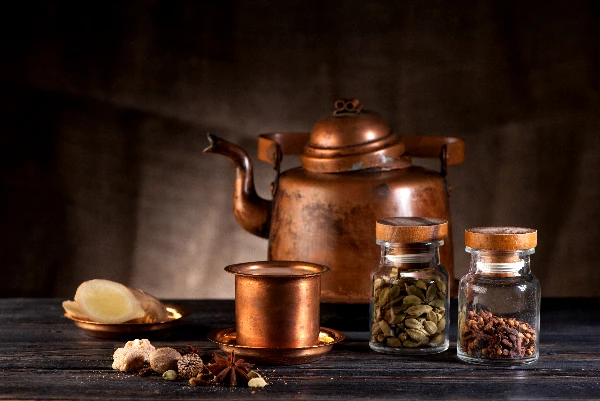
Conclusion
Reflecting on the journey we’ve taken through the world of chai tea, it’s clear that this beverage is more than just a drink; it embodies a rich history and myriad cultural influences that have evolved over centuries. From its ancient origins to the British colonial impact, chai tea’s evolution is a testament to its adaptability and significance across diverse societies. We’ve uncovered how traditional ingredients contribute to not only its unique flavour but also its impressive health benefits.
As we’ve explored the preparation of chai tea, from selecting the perfect black tea to balancing spices and milk, it’s evident that mastering this beverage allows for a personal touch that can cater to individual preferences. The variations of chai tea, be it Masala, Assam, or the delicate flavours of Darjeeling, showcase the beauty of cultural diversity and regional characteristics. The customization options we discussed enable the chai lover in each of us to experiment and create a brew that resonates with our taste.
Thinking about the next steps, I encourage you to take this newfound knowledge into your kitchen and embark on your chai journey. Whether you’re striving to perfect the classic recipe or eager to try your hand at variations or customizations, there’s a world of spice and flavour waiting to be discovered. Let each cup you brew be a moment of reflection on the rich tapestry of cultures and traditions that chai tea represents.
In conclusion, as you pour your next cup of chai, consider the journey it has taken to reach you and the potential it holds to fit into your own life. Remember the wise words of the poet Rumi: “The wound is the place where the Light enters you.” Make chai tea not just a beverage, but a meditative practice—a chance to embrace the warmth it brings.


